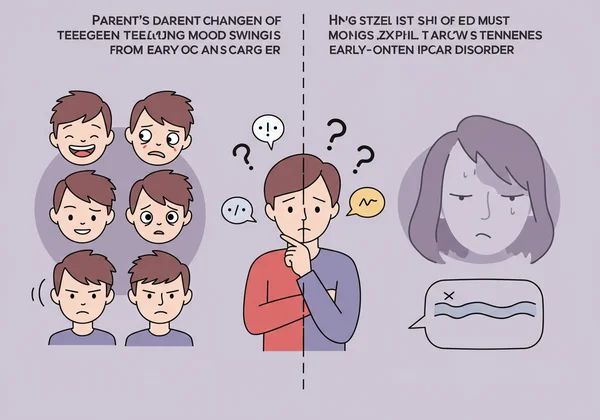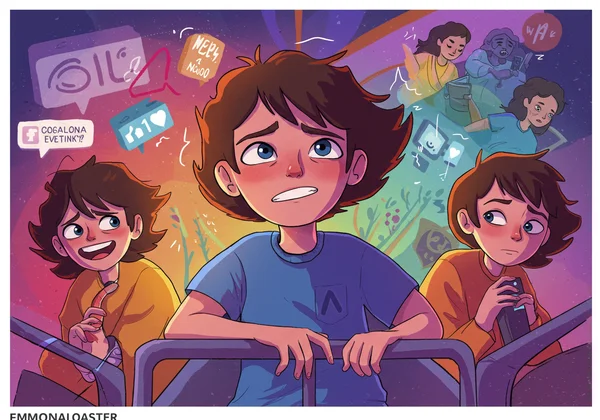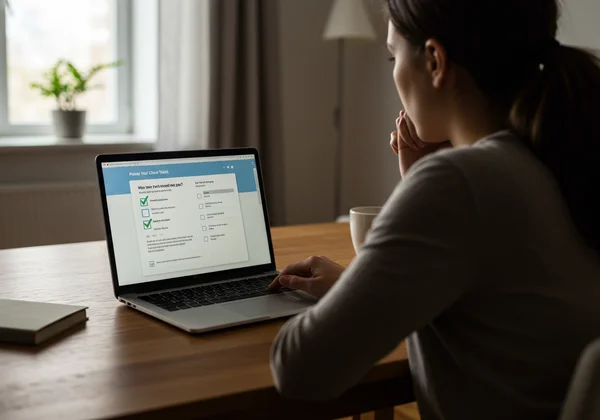Is It Bipolar or Teen Mood Swings? A Parent's Guide & Test
Navigating the tumultuous waters of adolescence is a challenge for any parent. The sudden shifts in emotion, the intense highs, and the crushing lows can be perplexing. But when do these behaviors cross the line from typical teenage moodiness to something more serious? For many concerned parents, a critical question arises: How do I know if this is early-onset bipolar disorder? This guide will help you understand the crucial difference between typical teen mood swings and the potential signs of adolescent bipolar disorder. Understanding this difference is key to providing the right support. A confidential teenage bipolar test can be an invaluable first step on that journey.

Understanding Typical Teen Mood Swings & Behavior
Before exploring the signs of a mood disorder, it's essential to have a baseline for what constitutes "normal" adolescent development. The teenage years are a period of immense change—hormonal, neurological, social, and emotional. This natural upheaval often manifests as behaviors that can seem erratic to adults.
The Adolescent Emotional Rollercoaster: What's 'Normal'?
It's common for teenagers to experience intense emotions. A fight with a friend can feel like the end of the world, while a new crush can bring euphoric happiness. These feelings are often powerful but are usually tied to specific events or situations. A key characteristic of typical emotional rollercoaster moments is that they are reactive and generally short-lived. Your teen might be irritable and withdrawn one evening but bounce back to their usual self after a good night's sleep or a positive interaction the next day. This reactivity, while exhausting, is often a part of the adolescent experience.

Distinguishing Everyday Reactivity from Persistent Patterns
The main difference between typical moodiness and a potential mood disorder is in how long, how intensely, and how often these emotional states occur. Everyday reactivity is situational. Your teen is upset because they failed a test or happy because they were invited to a party. While the reaction might seem disproportionate, there is a clear trigger. In contrast, the mood shifts associated with bipolar disorder are often less tied to external events. They emerge as distinct, persistent periods of elevated or depressed mood that significantly impact the teen's ability to function at school, at home, and with friends. It's the persistent mood patterns that should capture your attention.
Recognizing Key Bipolar Symptoms in Teens
Identifying potential bipolar disorder in an adolescent can be complex because its symptoms often overlap with other conditions like ADHD, depression, and even typical teenage behavior. However, there are specific signs that are more indicative of bipolar symptoms in teens. Bipolar disorder is characterized by distinct episodes of mania (or hypomania) and depression.
Mania & Hypomania in Adolescents: Beyond 'High Energy'
A manic or hypomanic episode isn't just about being in a good mood or having a lot of energy. In teenagers, it often presents as extreme irritability rather than euphoria. Key signs include:
- Decreased Need for Sleep: Sleeping only a few hours (or not at all) but still feeling incredibly energetic the next day.
- Rapid, Pressured Speech: Talking so fast that others can't keep up, jumping from one topic to another.
- Grandiose Beliefs: An inflated sense of self-importance, abilities, or talents that is out of touch with reality.
- Risky Behavior: Engaging in reckless activities without regard for consequences, such as reckless driving, substance abuse, or unsafe sexual encounters.
A manic episode in a teen is a noticeable and severe shift from their usual self, causing significant disruption.

Depressive Episodes: Is It Just 'The Blues' or Something More?
Teenage depression can be easily dismissed as "the blues," but a major depressive episode is much more severe and persistent. It's not just sadness; it's a pervasive state of hopelessness and emptiness. Signs of depressive episodes to watch for include:
-
Overwhelming Sadness or Numbness: A deep sense of despair or an inability to feel any emotion at all.
-
Loss of Interest: No longer enjoying activities or hobbies they once loved.
-
Significant Changes in Sleep or Appetite: Sleeping far more or less than usual, or a major change in eating habits leading to weight loss or gain.
-
Feelings of Worthlessness: Intense self-criticism and feelings of guilt or failure.
-
Physical Complaints: Frequent headaches, stomachaches, or other pains that have no clear medical cause.

Irritability, Rage, and Sleep: Unique Indicators in Youth
While adults with bipolar disorder often experience euphoric mania, adolescents are more likely to display extreme irritability, anger, and explosive rage during manic phases. These outbursts can seem to come from nowhere and are often disproportionate to the situation. Furthermore, severe sleep disturbances are a hallmark symptom. A sudden and dramatic decrease in the need for sleep can be a powerful indicator of a shift into a manic or hypomanic state. Observing these behavioral changes is crucial for early identification. For an initial look, you can get a free report.
When to Be Concerned: Differentiating & Seeking Help
As a parent, your intuition is powerful. If you feel something is fundamentally wrong, it is worth exploring. The key differentiator for adolescent bipolar disorder is the impact these mood episodes have on your teen's life.
The Impact Test: How Symptoms Affect Daily Life & Function
Are these mood swings causing serious problems? Consider the following:
- Academic Performance: Has there been a sudden and unexplained drop in grades?
- Relationships: Are friendships falling apart? Is there constant conflict with family members?
- Safety: Is your teen engaging in dangerous behaviors that put them or others at risk?
If the answer to these questions is yes, the behaviors are more than just typical teenage angst. They are signs of significant distress that warrant further investigation to support your teen's mental wellness.
Taking the First Step: Our Free Online Teenage Bipolar Test
Feeling overwhelmed and unsure where to turn is completely normal. A great, confidential first step is to use an online screening tool. Our teenage bipolar test is based on the scientifically validated Mood Disorder Questionnaire (MDQ) and aligned with DSM-5 criteria. It provides a safe, private space to organize your observations and gain initial insights into your teen’s symptoms. This is not a diagnosis, but it is a powerful tool to help you understand if the patterns you're seeing align with those of bipolar disorder. It can provide the clarity you need to take the next step. You can try our free tool today.

Preparing for a Professional Evaluation: What to Expect Next
If the results of an online screening suggest a potential issue, or if you remain concerned, the next step is a professional evaluation. Schedule an appointment with a child and adolescent psychiatrist or a psychologist who specializes in mood disorders. To prepare, start a journal to track your teen's moods, sleep patterns, and key behaviors. This documented information will be invaluable to the clinician. The goal is not just to get a label, but to get a comprehensive understanding that leads to an effective treatment plan.
Empowering Parents: Your Role in Support & Understanding
Discovering that your teen may have bipolar disorder can be frightening, but you are their most important advocate. Your love, support, and willingness to seek help are the most powerful tools you have. Remember to be patient with your teen and with yourself. The path to stability involves understanding, treatment, and hope. By educating yourself and taking proactive steps, you are empowering your child to manage their condition and live a full, meaningful life. Taking a moment to gain more clarity can be a positive and empowering first move.
Frequently Asked Questions About Teen Moods & Bipolar Disorder
How can I test if my teen is bipolar?
You cannot diagnose your teen at home, as a formal diagnosis must come from a qualified mental health professional. However, you can use a screening tool as a starting point. The free screening tool on our website is designed to help you identify patterns that may warrant professional attention. It helps structure your concerns before speaking with a doctor.
What are 5 signs of bipolar disorder in teenagers?
While symptoms vary, five common signs include: 1) Distinct episodes of elevated mood (mania/hypomania), often presenting as extreme irritability. 2) Periods of severe depression, hopelessness, or loss of interest. 3) A significantly decreased need for sleep without feeling tired. 4) Rapid, pressured speech and racing thoughts. 5) Impulsive, high-risk behaviors that are out of character.
Is adolescent bipolar disorder different from adult bipolar?
Yes, it can present differently. Teens are more likely to experience extreme irritability and rage during manic episodes rather than euphoria. They may also have more frequent mood shifts and a higher likelihood of co-occurring conditions like ADHD or anxiety disorders, which can complicate diagnosis and treatment.
What should I do after my teen completes an online bipolar screening test?
An online test is an informational tool, not a diagnosis. Regardless of the outcome, the results are best used as a conversation starter with a healthcare professional. If the screening indicates a high likelihood of bipolar disorder, schedule an appointment with a psychiatrist or psychologist. If it doesn't, but you are still concerned, it is still wise to seek a professional opinion. You can use the online bipolar test results as a guide for that conversation.
Disclaimer: This article is for informational purposes only and does not constitute medical advice. The content is not intended to be a substitute for professional medical advice, diagnosis, or treatment. Always seek the advice of a qualified health provider with any questions you may have regarding a medical condition. Never disregard professional medical advice or delay in seeking it because of something you have read on this website.